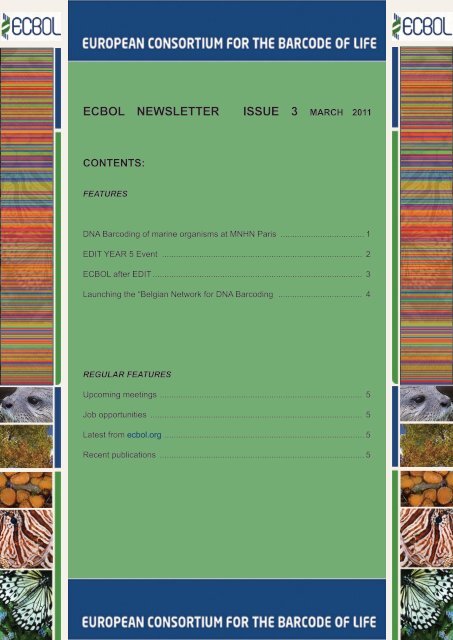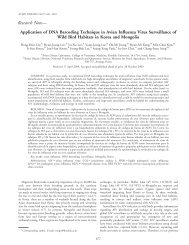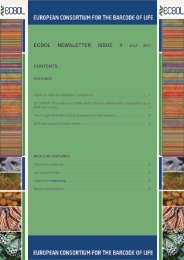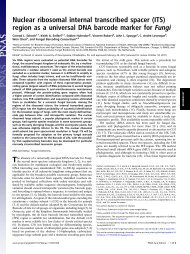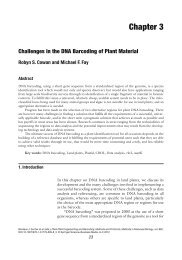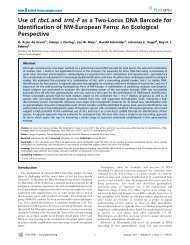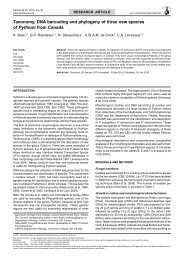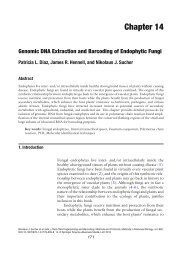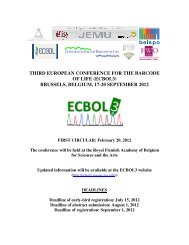ECBOL NEWSLETTER - European Consortium for the Barcode Of Life
ECBOL NEWSLETTER - European Consortium for the Barcode Of Life
ECBOL NEWSLETTER - European Consortium for the Barcode Of Life
You also want an ePaper? Increase the reach of your titles
YUMPU automatically turns print PDFs into web optimized ePapers that Google loves.
1 100 200 300 400 500 600 745<br />
Nucleotide Diversity<br />
Zero diversity Highest diversity<br />
1 100 200 300 400 500 600 745<br />
<strong>ECBOL</strong> <strong>NEWSLETTER</strong> ISSUE 3 MARCH 2011<br />
CONTENTS:<br />
FEATURES<br />
DNA Barcoding of marine organisms at MNHN Paris ..................................... 1<br />
EDIT YEAR 5 Event ....................................................................................... 2<br />
<strong>ECBOL</strong> after EDIT........................................................................................... 3<br />
Launching <strong>the</strong> “Belgian Network <strong>for</strong> DNA Barcoding .................................... 4<br />
REGULAR FEATURES<br />
Upcoming meetings ....................................................................................... 5<br />
Job opportunities ............................................................................................ 5<br />
Latest from ecbol.org ...................................................................................... 5<br />
Recent publications ......................................................................................... 5<br />
1 100 200 300 400 500 600 745<br />
Nucleotide Diversity<br />
Zero diversity Highest diversity<br />
1 100 200 300 400 500 600 745
The newsletter <strong>for</strong> <strong>the</strong> <strong>European</strong> <strong>Consortium</strong> <strong>for</strong> <strong>the</strong> <strong>Barcode</strong> of <strong>Life</strong> (<strong>ECBOL</strong>) is aimed at<br />
all members of <strong>the</strong> <strong>ECBOL</strong> community and o<strong>the</strong>rs that are interested in DNA barcoding and<br />
biodiversity in Europe and developing countries in Africa. The aim of this newsletter is to keep<br />
<strong>the</strong>se communities in<strong>for</strong>med on all issues related to DNA barcoding and biodiversity research<br />
and application in Europe. There<strong>for</strong>e, this newsletter will feature several short articles on<br />
various topics relevant to <strong>the</strong> <strong>ECBOL</strong> community. This will also include regular features to keep<br />
<strong>the</strong> community in<strong>for</strong>med about <strong>the</strong> latest developments.<br />
We would appreciate any contributions and comments regarding features in this newsletter<br />
as well as suggestions on improving <strong>the</strong> content and distribution of in<strong>for</strong>mation made available<br />
in this newsletter.<br />
Feel free to contact us at barcode@cbs.knaw.nl or visit us at www.ecbol.org.<br />
1 100 200 300 400 500<br />
DNA BARCODING OF MARINE<br />
ORGANISMS AT MNHN PARIS<br />
By Agnes Dettai<br />
There is a long tradition of studies on <strong>the</strong><br />
Sou<strong>the</strong>rn Ocean at <strong>the</strong> Museum National<br />
d’Histoire Naturelle in Paris, centered on <strong>the</strong><br />
Kerguelen archipelago and <strong>the</strong> East Antarctic<br />
Region (Dumont d’Urville Sea). As in o<strong>the</strong>r<br />
museums, <strong>the</strong> preservation methods of<br />
older specimens make DNA studies difficult,<br />
but <strong>the</strong>re have been a number of recent<br />
programs with recurrent access to <strong>the</strong>se two<br />
geographic sectors. Around Terre Adélie,<br />
IPEV programs like ICOTA (Ichtyologie<br />
Côtière en Terre Adélie, 1999-2008), or<br />
REVOLTA (Radiations Evolutives en Terre<br />
Adélie) have brought in a large number of<br />
Harknessia_sp.txt 1 -1<br />
Nucleotides<br />
T C A G<br />
samples compatible with molecular methods,<br />
while <strong>the</strong> fish biomass surveys POKER 2006<br />
and 2010 did <strong>the</strong> same <strong>for</strong> <strong>the</strong> Kerguelen<br />
Plateau. Collection was first focussed on<br />
teleost fish, but in recent years most benthic<br />
groups were also collected. Environmental<br />
parameters <strong>for</strong> each specimen are also<br />
recorded, and recently underwater videos<br />
have been added to explore finely <strong>the</strong> species<br />
assemblages. These are difficult to assess<br />
using solely <strong>the</strong> contents of fishing gears.<br />
Once <strong>the</strong> collected samples have been sent<br />
<strong>the</strong>re, <strong>the</strong> MNHN serves as a central node<br />
<strong>for</strong> sorting and dispatching <strong>the</strong>se materials.<br />
Depending on <strong>the</strong> taxa, <strong>the</strong> specimens are<br />
ei<strong>the</strong>r studied locally, or sent to Australian,<br />
Belgian, German or Italian specialists <strong>for</strong><br />
morphological and molecular analyses,<br />
including barcoding.<br />
But <strong>the</strong> longstanding expertise in<br />
taxonomy of <strong>the</strong> Sou<strong>the</strong>rn Ocean marine<br />
organisms at <strong>the</strong> MNHN is also used.<br />
Teleost fish, fea<strong>the</strong>rstars (Crinoidea), starfish<br />
(Asteroidea) and Tunicates are identified by<br />
MNHN scientists and sequenced locally, in<br />
collaboration with <strong>the</strong> Génoscope (Centre<br />
National de Séquencage, Evry). These<br />
taxonomic groups are part of barcodeinclusive<br />
research programs of several<br />
MNHN teams, like <strong>for</strong> instance project <strong>the</strong><br />
French ANR project ANTFLOCKs (Antarctic<br />
Species Flocks), and of our contribution to<br />
<strong>the</strong> Census of Antarctic Marine <strong>Life</strong>. Teleosts<br />
and fea<strong>the</strong>rstars are <strong>the</strong> groups whose<br />
study is most advanced. Large amounts of<br />
barcode data have been generated ei<strong>the</strong>r<br />
at <strong>the</strong> MNHN/Génoscope (Teleosts and<br />
fea<strong>the</strong>rstars), or in collaboration with <strong>the</strong><br />
Barcoding Center in Guelph (fea<strong>the</strong>rstars).<br />
Most of <strong>the</strong> sequences already generated<br />
are from Dumont d’Urville Sea specimens,<br />
but work has also started on <strong>the</strong> fauna of <strong>the</strong><br />
Kerguelen Plateau.<br />
Specimen collection in <strong>the</strong> Artic region<br />
The barcode data already generated<br />
<strong>for</strong> fea<strong>the</strong>rstars represents thousands of<br />
specimens from all over <strong>the</strong> Sou<strong>the</strong>rn Ocean,<br />
and has been completed with several o<strong>the</strong>r<br />
genes <strong>for</strong> an inclusive phylogeography.
Teleosts from <strong>the</strong>se areas are relatively<br />
well known, although a few new species<br />
are described each year. A dataset <strong>for</strong> more<br />
than five hundred specimens and eighty<br />
species, combining barcode sequences,<br />
morphological identification, and, <strong>for</strong> some<br />
taxa, additional markers has been established<br />
from <strong>the</strong> samples collected during <strong>the</strong> 2007-<br />
2008 international CAML CEAMARC survey<br />
(Collaborative East Antarctic Marine Census)<br />
on <strong>the</strong> eastern Antarctic shelf along Terre<br />
Adélie and George V Land. These sequences<br />
have considerably enlarged <strong>the</strong> Antarctic<br />
reference dataset in <strong>the</strong> BOLD, especially<br />
<strong>for</strong> hard to identify groups like snailfish<br />
(Liparidae) and eelpouts (Zoarcidae), where<br />
<strong>the</strong> type specimens of four new species have<br />
been sequenced. They also improved our<br />
knowledge of <strong>the</strong> evolution of <strong>the</strong> Sou<strong>the</strong>rn<br />
Ocean Teleosts, as <strong>the</strong> cytochrome oxidase I<br />
is a good marker <strong>for</strong> molecular phylogenetics<br />
at small and medium scale in <strong>the</strong> group.<br />
following years, both <strong>for</strong> this group and <strong>the</strong><br />
o<strong>the</strong>rs.<br />
EDIT YEAR 5 EVENT<br />
By Lorenzo Lombard<br />
Remaster species<br />
More than 550 East Antarctic starfish<br />
specimens have been sampled <strong>for</strong> barcode<br />
on <strong>the</strong> CEAMARC survey alone, and <strong>the</strong><br />
collection is being completed using <strong>the</strong><br />
REVOLTA program. The first hundred<br />
sequences have already raised some<br />
interesting taxonomic questions and added<br />
new and divergent sequences to <strong>the</strong> BOLD.<br />
Almost no barcode data is available <strong>for</strong><br />
Antarctic Ascidians yet, maybe because<br />
of <strong>the</strong> difficulty to amplify <strong>the</strong> COI <strong>for</strong> many<br />
species of this group. Specimens from 27<br />
species identified by F. Monniot, one of <strong>the</strong><br />
leading specialists <strong>for</strong> <strong>the</strong> Sou<strong>the</strong>rn Ocean<br />
ascidians, have been sequenced (including<br />
three new species), and will be released<br />
shortly, while a much larger dataset is in<br />
preparation. Taxonomic problems are arising<br />
with <strong>the</strong> inclusion of this new molecular<br />
data, and promise many discoveries in <strong>the</strong><br />
On 17-19 January 2011 <strong>the</strong> EDIT Year 5<br />
Event took place at <strong>the</strong> Muséum National<br />
d’Histoire Naturelle (MNHN) in Paris as <strong>the</strong><br />
last general meeting of <strong>the</strong> EDIT (<strong>European</strong><br />
Distributed Institute of Taxonomy) contract<br />
period. The three day event consisted of<br />
a roundtable meeting of <strong>the</strong> CETAF/EDIT<br />
Board of Directors on <strong>the</strong> first day followed<br />
by <strong>the</strong> main event on <strong>the</strong> second day.<br />
The main event consisted of a scientific<br />
conference which was opened by Gilles<br />
Boeuf, President of <strong>the</strong> MNHN Paris. The<br />
conference consisted of eight invited talks<br />
divided over four sessions that included <strong>the</strong><br />
topics “From nature to notion, from field to<br />
1 100 200 300 400 500<br />
Nucleotide Diversity<br />
Zero diversity Highest diversity<br />
data”, “Data driven processes”, “Producing<br />
and sharing biodiversity data, in<strong>for</strong>mation<br />
and knowledge” and “Training and Public<br />
Outreach”. All eight invited talks highlighted<br />
<strong>the</strong> importance of biodiversity and taxonomy<br />
in Europe and how EDIT has laid a foundation<br />
<strong>for</strong> <strong>the</strong> continued study and application of<br />
<strong>the</strong>se disciplines in Europe after <strong>the</strong> period<br />
of EDIT. The third day consisted of side<br />
events that included various workshops<br />
1 100 200 300 400 500
1 100 200 300 400 500<br />
and meetings of EDIT components to be<br />
continued after <strong>the</strong> period of EDIT.<br />
Extract from EDIT Year 5 Event Programme<br />
In his talk titled “reverse taxonomy”,<br />
Pedro Crous (CBS-KNAW, <strong>the</strong> Ne<strong>the</strong>rlands)<br />
illustrated how DNA barcoding basically<br />
changed <strong>the</strong> way in which we presently look<br />
at microbial biodiversity, namely to sequence<br />
Harknessia_sp.txt 1 -1<br />
Nucleotides<br />
T C A G<br />
first, and ask questions later. Basically this<br />
approach has led to an expedited discovery<br />
of microbial life (in soil, rocks, water, air, and<br />
organic substrates). Due to DNA barcoding<br />
<strong>the</strong> biggest challenge that systematists will<br />
face in future will no longer be recognising<br />
undescribed taxa, but increasing <strong>the</strong> rate in<br />
which taxonomists can publish taxonomic<br />
novelties, and doing so in a manner that<br />
<strong>the</strong>se data are immediately available to<br />
<strong>the</strong> community in an intelligent fashion,<br />
interlinked with major online repositories and<br />
biodiversity initiatives.<br />
<strong>ECBOL</strong> AFTER EDIT<br />
By Lorenzo Lombard<br />
The partners of <strong>the</strong> <strong>European</strong> <strong>Consortium</strong><br />
<strong>for</strong> <strong>the</strong> <strong>Barcode</strong> of <strong>Life</strong> (<strong>ECBOL</strong>) have<br />
reached a Memorandum of Understanding<br />
(MOU) on how to sustain <strong>ECBOL</strong> beyond<br />
<strong>the</strong> termination of <strong>the</strong> EDIT contract. One<br />
of <strong>the</strong> major goals of this MOU is to sustain<br />
<strong>the</strong> coordination activities in <strong>the</strong> field of DNA<br />
barcoding in Europe that was initiated with<br />
financial support from <strong>the</strong> EDIT network.<br />
The MOU was distributed to all <strong>the</strong><br />
EDIT Directors, team leaders and <strong>the</strong> EDIT<br />
Network Steering Committee on 9 December<br />
2010. One of <strong>the</strong> essential pillars in this<br />
support from EDIT was <strong>the</strong> appointment of<br />
an <strong>ECBOL</strong> coordinator, Dr Lorenzo Lombard,<br />
who is currently stationed at <strong>the</strong> CBS-KNAW<br />
in Utrecht, The Ne<strong>the</strong>rlands. In collaboration<br />
with NCB-Naturalis in Leiden, <strong>the</strong> Dutch<br />
node of EDIT will continue to provide in-kind<br />
administrative and organisational support <strong>for</strong><br />
<strong>ECBOL</strong> to ensure it continuation <strong>for</strong> <strong>the</strong> next<br />
four years. Fur<strong>the</strong>rmore, <strong>the</strong> partners of this<br />
MOU recognise <strong>the</strong> importance of long-term<br />
institutional collaboration and integration,<br />
and that <strong>the</strong> <strong>ECBOL</strong> coordinator will have to<br />
continue and play a key-role in highlighting<br />
funding opportunities, and interaction with<br />
<strong>the</strong> International <strong>Barcode</strong> of <strong>Life</strong> (IBOL) at<br />
Guelph in Canada, and <strong>the</strong> <strong>Consortium</strong> <strong>for</strong> <strong>the</strong><br />
<strong>Barcode</strong> of <strong>Life</strong> (CBOL) at <strong>the</strong> Smithsonian<br />
in <strong>the</strong> USA. While activities that <strong>ECBOL</strong><br />
partners will be able to undertake in future<br />
to sustain <strong>ECBOL</strong> are subject to availability<br />
of funds, in effect this is <strong>the</strong> only realistic<br />
business model to achieve <strong>the</strong> sustainability<br />
of this network in <strong>the</strong> long term.<br />
In view of <strong>the</strong> conclusion of <strong>the</strong> EDIT<br />
network on <strong>the</strong> 28 th of February 2011, <strong>the</strong><br />
partners devised <strong>the</strong> MOU with <strong>the</strong> aim of<br />
continued collaboration of <strong>the</strong> institutions<br />
in <strong>the</strong> CETAF (<strong>Consortium</strong> of <strong>European</strong><br />
Taxonomic Facilities) framework. The<br />
Ne<strong>the</strong>rlands Centre of Biodiversity (NCB,<br />
including EDIT partners NHM-Leiden<br />
and ZMA) was granted 30 million Euro in<br />
September 2009, which opened thus far <strong>the</strong><br />
only opportunity <strong>for</strong> financial support <strong>for</strong> <strong>the</strong><br />
continued coordination of barcoding activities<br />
in Europe. The amount available out of <strong>the</strong><br />
NCB funds will allow <strong>the</strong> extension of <strong>the</strong><br />
contract of <strong>the</strong> <strong>ECBOL</strong> coordinator office in<br />
Utrecht until 2014.<br />
A consortium management structure<br />
roadmap is envisaged <strong>for</strong> <strong>ECBOL</strong> after<br />
<strong>the</strong> termination of <strong>the</strong> EDIT contract. This<br />
roadmap is closely related to <strong>the</strong> management<br />
roadmap of <strong>the</strong> International <strong>Barcode</strong> of<br />
<strong>Life</strong> (iBOL). With this roadmap <strong>ECBOL</strong> will<br />
continue to have member organisations from
as many as possible <strong>European</strong> countries.<br />
These member organisations are typically<br />
natural history museums, zoological and<br />
botanical gardens, herbaria, university<br />
departments, private biotech companies<br />
and o<strong>the</strong>r policy directed bodies such as<br />
biodiversity organisations and governmental<br />
and intergovernmental organisations.<br />
<strong>ECBOL</strong> will continue to apply <strong>for</strong> <strong>European</strong><br />
funding, and more importantly, also stimulate<br />
<strong>the</strong> activities in national networks across<br />
Europe. Funds will be used <strong>for</strong> activities<br />
linked to iBOL. The separate institutions<br />
making up <strong>the</strong> <strong>ECBOL</strong> consortium are<br />
represented in <strong>the</strong> Core Group, which is an<br />
advisory body to <strong>the</strong> consortium. <strong>ECBOL</strong><br />
will continue to advise institutions of a<br />
specific country to <strong>for</strong>m national networks.<br />
These national networks can apply <strong>for</strong> and<br />
use country specific funds. The <strong>European</strong><br />
Network of Leading Labs (NELL), will consist<br />
of representatives from <strong>the</strong> various <strong>European</strong><br />
laboratories, which will be responsible <strong>for</strong><br />
<strong>the</strong> DNA Barcoding pipelines in <strong>the</strong> various<br />
leading labs of <strong>the</strong> consortium. The <strong>ECBOL</strong><br />
consortium will have three advisory bodies,<br />
CETAF, NELL, and <strong>the</strong> Scientific Advisory<br />
Council.<br />
<strong>ECBOL</strong> will continue collaborations with<br />
<strong>the</strong> <strong>Consortium</strong> <strong>for</strong> <strong>the</strong> Barcoding of <strong>Life</strong><br />
(CBOL) and <strong>the</strong> International <strong>Barcode</strong> of <strong>Life</strong><br />
(iBOL) initiative in regards to drafting norms,<br />
assembling protocols, networking, raising<br />
awareness, capacity building and lowering<br />
<strong>the</strong> barriers to barcode assembly. Although<br />
<strong>ECBOL</strong> is striving to be a Central Node in<br />
iBOL, lack of funding <strong>for</strong> barcoding in Europe,<br />
as funds are only available <strong>for</strong> coordination,<br />
could result in <strong>European</strong> countries initially<br />
affiliating at national level to IBOL, until a<br />
major <strong>European</strong> grant has been obtained.<br />
In <strong>the</strong> meantime <strong>ECBOL</strong> will continue to try<br />
and obtain funding <strong>for</strong> barcoding to meet <strong>the</strong><br />
requirements to act as a Central Node.<br />
The <strong>ECBOL</strong> website (http://www.ecbol.<br />
org) is an important plat<strong>for</strong>m <strong>for</strong> <strong>the</strong> <strong>ECBOL</strong><br />
community. It has been revamped and will<br />
be maintained and continuously updated<br />
with current in<strong>for</strong>mation of <strong>European</strong> and<br />
international DNA barcoding activities. This<br />
website will also be used to link various<br />
barcoding labs in Europe and keep <strong>the</strong>m<br />
abreast of <strong>the</strong> latest in<strong>for</strong>mation. Fur<strong>the</strong>rmore,<br />
a quarterly <strong>ECBOL</strong> newsletter has been<br />
successfully launched that is distributed<br />
through a mail service to <strong>European</strong> barcoding<br />
labs and is also freely available through <strong>the</strong><br />
<strong>ECBOL</strong> website.<br />
LAUNCHING THE “BELGIAN NETWORK<br />
FOR DNA BARCODING”<br />
By Thierry Backeljau & Marc De Meyer<br />
Although, hi<strong>the</strong>rto, relatively few Belgian<br />
research groups have been actively involved<br />
in DNA barcoding, <strong>the</strong>re are some notable<br />
exceptions, such as <strong>the</strong> “Joint Experimental<br />
Molecular Unit (JEMU)”. JEMU is a research<br />
team that was created jointly by <strong>the</strong> Royal<br />
Belgian Institute of Natural Sciences (RBINS,<br />
Brussels, Belgium) and <strong>the</strong> Royal Museum<br />
<strong>for</strong> Central Africa (RMCA, Tervuren, Belgium)<br />
and that is financed by <strong>the</strong> federal Belgian<br />
Science Policy <strong>Of</strong>fice. It was established in<br />
2007 and employs four researchers (two<br />
postdocs, and two assistants), with <strong>the</strong> aim<br />
to conduct molecular systematic research<br />
in function of ongoing programmes of and<br />
in collaboration with scientist from both<br />
institutes. This entails two major lines of work:<br />
(1) testing, exploring and improving protocols<br />
<strong>for</strong> DNA extraction and amplification from<br />
degraded museum samples, and (2) DNA<br />
barcoding. JEMU’s interest in DNA barcoding<br />
1 100 200 300 400 500<br />
Nucleotide Diversity<br />
Zero diversity Highest diversity<br />
is not only reflected by several of its past<br />
and ongoing DNA barcoding programmes,<br />
but also by <strong>the</strong> fact that <strong>the</strong> JEMU funding<br />
(1,240,000 €) was designated as a matching<br />
fund <strong>for</strong> <strong>the</strong> International <strong>Barcode</strong> of <strong>Life</strong><br />
(iBOL) project. More in<strong>for</strong>mation about JEMU<br />
can be found at http://jemu.myspecies.info/.<br />
In <strong>the</strong> course of <strong>the</strong> JEMU functioning<br />
during <strong>the</strong> past four years, it became clear<br />
that several o<strong>the</strong>r Belgian research groups<br />
1 100 200 300 400 500
1 100 200 300 400 500<br />
had a strong interest to become involved<br />
in DNA barcoding activities. To this end,<br />
some of <strong>the</strong>se research groups established<br />
a collaboration with JEMU to develop joint<br />
DNA barcoding projects focusing on specific<br />
taxa, often within well-delimited geographic<br />
areas (e.g. Congo River Basin, Antarctica,<br />
Macaronesia, ...), while o<strong>the</strong>r research<br />
groups started <strong>the</strong>ir DNA barcoding studies<br />
independently. Yet, <strong>for</strong> several teams DNA<br />
barcoding was still in some sort of planning<br />
or upstart stage. This new but relatively<br />
disparate emergence of DNA barcoding<br />
in Belgium, soon gave rise to a growing<br />
feeling that it would be advantageous if<br />
Belgian DNA barcoding activities were<br />
facilitated, supported and coordinated by<br />
some sort of network structure that could<br />
act as an (inter)national contact, liaison and<br />
in<strong>for</strong>mation center. Against this background,<br />
and stimulated by <strong>the</strong> federal Belgian<br />
Science Policy <strong>Of</strong>fice, JEMU organized<br />
an in<strong>for</strong>mal workshop “Towards a Belgian<br />
network of DNA barcoding laboratories”,<br />
with <strong>the</strong> aim to explore <strong>the</strong> feasibility of<br />
creating a sustainable DNA barcoding<br />
network in Belgium. The meeting was held<br />
at RBINS on June 28th 2010 and ga<strong>the</strong>red<br />
26 participants (a report on this meeting<br />
can be downloaded at http://www.ecbol.org/<br />
docs/Report%20on%20<strong>the</strong>%20meeting%20<br />
28062010.pdf; <strong>the</strong> minutes of <strong>the</strong> meeting<br />
can be found at http://www.ecbol.org/docs/<br />
Harknessia_sp.txt 1 -1<br />
Nucleotides<br />
T C A G<br />
Minutes%20BelgianNetworkBarcoding.<br />
pdf). The conclusion of <strong>the</strong> meeting was<br />
that JEMU would draft an application <strong>for</strong> <strong>the</strong><br />
funding of a “Scientific Research Network” to<br />
be submitted at <strong>the</strong> “Research Foundation -<br />
Flanders (FWO)” and so this was done.<br />
Fortunately, <strong>the</strong> FWO application was<br />
successful and hence, since January<br />
1st 2011 <strong>the</strong> “Belgian Network <strong>for</strong> DNA<br />
Barcoding” has become a fact! Currently,<br />
<strong>the</strong> network comprises 20 Belgian research<br />
groups representing a wide array of <strong>the</strong>matic<br />
interests, including taxonomy, phylogeny,<br />
population genetics, ecology, conservation<br />
biology, tropical medicine, agricultural<br />
and <strong>for</strong>ensic sciences. Taxonomically <strong>the</strong><br />
network covers all types of organisms, even<br />
though <strong>the</strong> majority of <strong>the</strong> participating<br />
teams deal with animals. The international<br />
link of <strong>the</strong> network is provided by <strong>the</strong><br />
<strong>European</strong> <strong>Consortium</strong> <strong>for</strong> <strong>the</strong> <strong>Barcode</strong><br />
of <strong>Life</strong> (<strong>ECBOL</strong>) and <strong>the</strong> <strong>Consortium</strong> <strong>for</strong><br />
<strong>the</strong> <strong>Barcode</strong> of <strong>Life</strong> (CBOL), which both<br />
are full members of <strong>the</strong> consortium. The<br />
network is secured <strong>for</strong> a funding period of<br />
five years (2011-2015 with 12,500 €/year)<br />
to realize its goals, viz. (1) to coordinate<br />
<strong>the</strong> ef<strong>for</strong>ts and knowledge in <strong>the</strong> field of<br />
molecular systematics and DNA barcoding<br />
in Belgium, (2) to exchange methodological<br />
and interpretative expertise, (3) to provide<br />
training opportunities in <strong>the</strong> field of<br />
molecular systematics and DNA barcoding,<br />
(4) to stimulate and support joint research<br />
activities and project applications with<br />
respect to molecular systematics and DNA<br />
barcoding, and (5) to act as Belgian contact<br />
point <strong>for</strong> international initiatives such as<br />
CBOL, <strong>ECBOL</strong> and iBOL. These goals<br />
will be achieved by, amongst o<strong>the</strong>rs, (1)<br />
developing and maintaining a scratchpad<br />
based website (see http://scratchpads.<br />
eu/), (2) organizing meetings, workshops,<br />
seminars and short courses, (3) providing<br />
in<strong>for</strong>mation on funding possibilities and<br />
upcoming events, (4) establishing a<br />
plat<strong>for</strong>m <strong>for</strong> in<strong>for</strong>mation exchange, and (5)<br />
generating joint research outputs.<br />
The network will be run and managed by<br />
JEMU at RBINS and RMCA. As such, we<br />
hope that <strong>the</strong> network will generate lots<br />
of new research opportunities, new (inter)<br />
national collaborations and new funding<br />
possibilities!
UPCOMING MEETINGS:<br />
• NBOL meeting – CBS-KNAW Fungal Biodiversity Centre, Utrecht, The Ne<strong>the</strong>rlands<br />
– 14 April 2011<br />
• Fungal Barcoding Workshop – CBS-KNAW Fungal Biodiversity Centre, Utrecht, The<br />
Ne<strong>the</strong>rlands – 17-18 April 2011<br />
• Pacific Science Congress: DNA barcoding of Invasive Species – Kuala Lumpur, Malaysia<br />
– 14-18 June 2011<br />
• International Botanical Congress (IBC2011) – Melbourne, Australia – 23-30 July 2011<br />
• 4 th International <strong>Barcode</strong> of <strong>Life</strong> Conference – Adelaide, Australia – 28 November-3<br />
December 2011<br />
• 10 th Invertebrate Biodiversity & Conservation Conference – Melbourne, Australia – 4-7<br />
December 2011<br />
If you are planning a DNA barcoding or biodiversity related meeting, workshop or course,<br />
please contact us at barcode@cbs.knaw.nl to spread <strong>the</strong> word to o<strong>the</strong>r members of <strong>the</strong> <strong>ECBOL</strong><br />
community!!<br />
JOB OPPORTUNITIES:<br />
• Postdoctoral positions available at NCB Naturalis (www.ncbnaturalis.nl).<br />
If you know of or have any positions available regarding DNA barcoding or biodiversity and<br />
wish to advertise <strong>the</strong>se positions in this newsletter or on <strong>the</strong> <strong>ECBOL</strong> website, please contact<br />
us at barcode@cbs.knaw.nl.<br />
LATEST FROM <strong>ECBOL</strong>.ORG:<br />
The official <strong>ECBOL</strong> website, www.ecbol.org, features several new pages that include <strong>the</strong> latest<br />
in<strong>for</strong>mation on:<br />
• Funding opportunities<br />
• Publications<br />
• Upcoming meetings and courses<br />
• Job opportunities<br />
• Activities on Connect (http://www.connect.barcodeoflife.net)<br />
If you wish to contribute to or comment on any of <strong>the</strong>se new features and o<strong>the</strong>r features or wish<br />
to have more in<strong>for</strong>mation made available on www.ecbol.org, please contact Lorenzo Lombard<br />
at barcode@cbs.knaw.nl.<br />
RECENT PUBLICATIONS:<br />
• Shufran KA, Puterka GJ. 2011. DNA barcoding to identify all life stages of holocyclic cereal<br />
aphids (Hemiptera: Aphididae) on wheat and o<strong>the</strong>r Poaceae. Ann. Entomol. Soc. Am.<br />
104(1): 39-42.<br />
• Pilgrim EM, Jackson SA, Swenson S, Turcsanyi I, Friedman E, Weigt L, Bagle MJ. 2011.<br />
Incorporation of DNA barcoding into large-scale biomonitoring program: opportunities and<br />
pitfalls. Journal of <strong>the</strong> North American Benthological Society 30(1): 217-231.<br />
• de Groot GA, During HJ, Maas JW, Schneider H, Vogel JC, Erkens RHJ. 2011. Use of<br />
rbcL and trnL-F as a two-locus DNA barcode <strong>for</strong> identification of NW-<strong>European</strong> ferns: An<br />
ecological perspective. PLoS ONE 6(1): e16371. doi:10.1371/journal.pone.0016371.<br />
• Hausmann A, Haszprunar G, Hebert PDN. 2011. DNA barcoding <strong>the</strong> Geometrid fauna<br />
of Bavaria (Lepidoptera): successes, surprises and questions. PLoS ONE 6(2): e17134<br />
doi:10.1371/journal.pone.0017134<br />
All <strong>the</strong>se scientific publications and more are available on www.ecbol.org.<br />
1 100 200 300 400 500<br />
Nucleotide Diversity<br />
Zero diversity Highest diversity<br />
1 100 200 300 400 500
SPONSORS:<br />
The <strong>ECBOL</strong> Newsletter will be published quarterly by <strong>the</strong> <strong>European</strong> <strong>Consortium</strong> <strong>for</strong> <strong>the</strong><br />
<strong>Barcode</strong> of <strong>Life</strong> as part of <strong>the</strong> EDIT network.<br />
1 100 200 300 400 500<br />
Harknessia_sp.txt 1 -1<br />
Nucleotides<br />
T C A G<br />
Design and Layout: Lorenzo Lombard & Manon van den Hoeven-Verweij<br />
Please send your contributions, comments or suggestions to barcode@cbs.knaw.nl or to:<br />
Dr. L. Lombard<br />
Coordinator: <strong>European</strong> <strong>Consortium</strong> <strong>for</strong> <strong>the</strong> <strong>Barcode</strong> of <strong>Life</strong><br />
CBS-KNAW Fungal Biodiversity Centre<br />
Uppsalalaan 8<br />
3584 CT Utrecht<br />
The Ne<strong>the</strong>rlands<br />
Tel: +31 (0)30 212 2687<br />
Fax: +31 (0)30 251 2097


